Museums, memorials, monuments, and more
The grassy expanse of the National Mall – the nation’s front lawn – is home to a huge variety of iconic museums, monuments, and government facilities. At two miles long, with extensions that include the White House (to the north) and the Jefferson and Roosevelt memorials (to the south), it’s a big place. While it can be walked in a day, there is a lot to see here and visitors with enough time should spread their visit over several days.
The following lists all the major monuments and museums along the way if one were to tour the entire park starting from the Smithsonian Metro stop and making a loop by walking east along the south side of the mall to the US Capitol, across the Mall to the north, west along the north side of the Mall (including the White House), south past the Lincoln Memorial to the Jefferson Memorial, and back along the Tidal basin to the Metro stop.
Freer Gallery of Art
The Freer Gallery of Art displays part of the Smithsonian’s Asian art collection (the rest is at the neighboring Sackler Gallery.) It is also home to a significant collection of art by James McNeill Whistler, including his completely over-the-top Peacock Room from the Frederick R. Leyland home in London.
Sackler Gallery (Asian art)
The Arthur M. Sackler Gallery is the Freer’s sister institute and displays a broad range of Asian art dating from antiquity to today. When I last visited, exhibits featured sculpture from South India, ancient Iranian metalwork, artists working in Afghanistan today, Islamic ceramics, photographs from rural Rajasthan, and elaborate Qur’ans on loan from a museum in Istanbul.
Together with the Freer, this is one of my favorite museums in DC. The Smithsonian’s Asian collection is simply gorgeous and visiting this serene space is a joy.
Museum of African Art
The Museum of African Art exhibits ancient and contemporary art from across Africa. The museum is home to a lively and exciting collection from across Africa, including works from the fabulous Walt Disney-Tishman African Art Collection.
Smithsonian Castle
 The historic home of the Smithsonian is the 1855 “Castle” designed by James Renwick. At the time it housed the offices of the Smithsonian’s secretary, research facilities, exhibition space, and living quarters for the Secretary’s family. Today it serves as a visitor center and café.
The historic home of the Smithsonian is the 1855 “Castle” designed by James Renwick. At the time it housed the offices of the Smithsonian’s secretary, research facilities, exhibition space, and living quarters for the Secretary’s family. Today it serves as a visitor center and café.
The surrounding gardens are a pleasant place to relax.
Arts and Industries Building
 Connected to the Smithsonian Castle by gardens, the Arts and Industries Building was constructed in 1881 to serve as the US National Museum. When opened, it housed most of the Smithsonian’s collection. Soon other buildings were added to the Smithsonian’s holdings as the collection grew and the Arts and Industries Building was closed in 2006. A renovation of the rapidly deteriorating building was completed in 2014, but this gorgeous structure remains largely empty and unused as of fall 2016.
Connected to the Smithsonian Castle by gardens, the Arts and Industries Building was constructed in 1881 to serve as the US National Museum. When opened, it housed most of the Smithsonian’s collection. Soon other buildings were added to the Smithsonian’s holdings as the collection grew and the Arts and Industries Building was closed in 2006. A renovation of the rapidly deteriorating building was completed in 2014, but this gorgeous structure remains largely empty and unused as of fall 2016.
Hirshhorn Museum and Sculpture Garden
The Hirshhorn Museum is the Smithsonian’s modern art museum. The museum and its adjacent plaza and (sunken) sculpture garden feature modern masters and cutting-edge emerging artists. I’m not much of a modernist, so haven’t spent a lot of time here, but with work by Miro, Moore, Rodin, and Hopper there is something here for everyone. The permanent collection was re-hung recently, so visitors who haven’t been here awhile have yet another reason to return.
National Air and Space Museum
 The Air and Space Museum is one of the Mall’s most popular venues and is sure to be swarming with visitors of all ages at all times. It’s worth facing the crowd though to see icons of aviation history like the Wright brothers 1903 “airplane,” Lindberg’s Spirit of St. Louis, and a WWI German Fokker; spacecraft like the Apollo 11 command module; and a wealth of photos and other artifacts (including moon rocks).
The Air and Space Museum is one of the Mall’s most popular venues and is sure to be swarming with visitors of all ages at all times. It’s worth facing the crowd though to see icons of aviation history like the Wright brothers 1903 “airplane,” Lindberg’s Spirit of St. Louis, and a WWI German Fokker; spacecraft like the Apollo 11 command module; and a wealth of photos and other artifacts (including moon rocks).
There is a café in the Air and Space Museum.
National Museum of the American Indian
One of our favorite museums, the National Museum of the American Indian covers the native cultures of North and South America. The museum features cross-cultural themes like play and Native ceremonies; provides an in-depth look at historic sites like the Inca road, the history of specific people like the Chesapeake area Algonquian, and issues like the treaties with the American Indian nations; and highlights individual artists like photographer Horace Poolaw. It also hosts cultural events and performances.
The museum’s Mitsitam Café features Native-inspired foods and the museum gift shop is one of two places in DC to buy high quality American Indian jewelry.
- Horses! (At the Museum of the American Indian)
- Where Better to Spend a Blustery Day than in a Museum?
- American Indian Art & Culture
US Botanic Garden
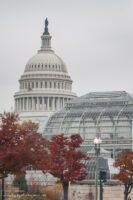 Located on the Mall at the base of Capitol Hill, US Botanic Garden provides a peaceful green escape within sight of the Capitol Dome. The Botanic Garden has three components: the historic conservatory with its collection of warm-weather plants from around the world, the courtyard gardens of the National Garden, and the themed gardens of nearby Bartholdi Park.
Located on the Mall at the base of Capitol Hill, US Botanic Garden provides a peaceful green escape within sight of the Capitol Dome. The Botanic Garden has three components: the historic conservatory with its collection of warm-weather plants from around the world, the courtyard gardens of the National Garden, and the themed gardens of nearby Bartholdi Park.
United States Capitol and Capitol Visitor Center
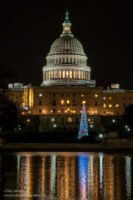 The United States Capitol building is both the working seat of government where Congress meets and a significant historic site. Despite the crowds, it’s amazing to see where so much history was made. I particularly like the Old Senate Chamber where Daniel Webster debated his colleagues over the role of the federal government and expansion of slavery. With the recent addition of a large visitor center, visitors have a wealth of resources for planning a visit – but it is still necessary to book tours in advance.
The United States Capitol building is both the working seat of government where Congress meets and a significant historic site. Despite the crowds, it’s amazing to see where so much history was made. I particularly like the Old Senate Chamber where Daniel Webster debated his colleagues over the role of the federal government and expansion of slavery. With the recent addition of a large visitor center, visitors have a wealth of resources for planning a visit – but it is still necessary to book tours in advance.
National Gallery of Art – East and West Buildings and Sculpture Garden
The National Gallery of Art was established in 1937 as a gift to the nation from Andrew W. Mellon. The gallery has three components: the original West Building, the 1970’s East Building, and the 1999 Art Sculpture Garden. The gallery’s collection includes a broad range of American and European art. It is not part of the Smithsonian Institute.
National Archives
Just across the street to the north of the Mall, the National Archives is the official repository for the nation’s official documents. The Archives has an amazing collection, some of which is on display, including original copies of the Declaration of Independence, Constitution, and Bill of Rights. It’s a fascinating stop even just to see the original documents (and who signed with a bold flourish and who may have offered their signature more reluctantly).
Museum of Natural History
The Smithsonian’s National Museum of Natural History covers all parts of the natural world, with collections that include specimens from the prehistoric world to today. Exhibits featuring dinosaurs and animals are likely to be swarming with children, but there is something here for everyone. The museum includes a café.
Museum of American History
The Smithsonian’s National Museum of American History is a lot like your crazy uncle’s attic, with great grandfather’s army uniform, his aunt’s wedding china, some old tools, and lots more – except here the collection includes the original Star Spangled Banner, George Washington’s uniform, Dorothy’s ruby slippers, some Muppets, and much, much more. The museum has a couple of cafes.
Museum of African American History and Culture
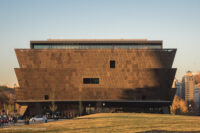 The newest of the Smithsonian museums, the recently opened National Museum of African American History and Culture is said to be fabulous, but right now entry is only available via a timed ticket. A few early morning visitors can get a ticket on arrival, but at least for the first part of 2017, visitors should arrange tickets far in advance if they hope to see the museum. The museum includes a café with an African-American inspired menu.
The newest of the Smithsonian museums, the recently opened National Museum of African American History and Culture is said to be fabulous, but right now entry is only available via a timed ticket. A few early morning visitors can get a ticket on arrival, but at least for the first part of 2017, visitors should arrange tickets far in advance if they hope to see the museum. The museum includes a café with an African-American inspired menu.
Washington Monument
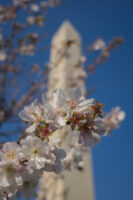 Begun in 1848 to honor the nation’s first president, the Washington Monument was finally completed in 1884. (There was a period of 25 years when no work at all was done on it.) The monument is 555 high at its highest point with an observation deck that provides a panoramic view of the city. There is a museum on the level below the observation deck; however, both the observation deck and museum are closed as the elevator awaits modernization. The monument is expected to reopen in 2019.
Begun in 1848 to honor the nation’s first president, the Washington Monument was finally completed in 1884. (There was a period of 25 years when no work at all was done on it.) The monument is 555 high at its highest point with an observation deck that provides a panoramic view of the city. There is a museum on the level below the observation deck; however, both the observation deck and museum are closed as the elevator awaits modernization. The monument is expected to reopen in 2019.
White House and President’s Park
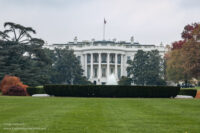 A short detour off the Mall to the north leads to the White House, the home and office of the President of the United States. Although this is one of the most recognizable buildings in the world, it didn’t always look like we see it today. Located on a site chosen by President Washington, the White House was first occupied in 1800, set afire by the British in 1814, and restored and reoccupied in 1817. The West Wing, where the Oval Office is located, was added in 1902. The East Wing, which is filled with staff offices, was added in 1942.
A short detour off the Mall to the north leads to the White House, the home and office of the President of the United States. Although this is one of the most recognizable buildings in the world, it didn’t always look like we see it today. Located on a site chosen by President Washington, the White House was first occupied in 1800, set afire by the British in 1814, and restored and reoccupied in 1817. The West Wing, where the Oval Office is located, was added in 1902. The East Wing, which is filled with staff offices, was added in 1942.
Visitors can view the exterior of the White House from across a vast expanse of lawn, but those wanting to see the interior need to arrange advance tickets through a member of Congress or a foreign embassy. There are a limited number of tickets, so plan well ahead. Keep in mind that cameras with removable lenses (and a lot of other things) are not allowed inside, so be sure to know the rules before you go.
(I last toured the White House on a family vacation during the Carter administration. Fortunately, my parents were much better about planning that sort of thing than I am.)
The nearby White House Visitor Center allows visitors to take a virtual tour, view artifacts from the White House, and watch a film about the White House.
Renwick Gallery
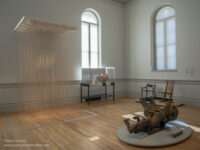 Housed in the first American building designed specifically as an art museum, the Renwick Gallery features contemporary American craft and decorative arts from the Smithsonian collections. This is one of my favorite museums, with a wonderful permanent collection and gorgeous temporary exhibits.
Housed in the first American building designed specifically as an art museum, the Renwick Gallery features contemporary American craft and decorative arts from the Smithsonian collections. This is one of my favorite museums, with a wonderful permanent collection and gorgeous temporary exhibits.
- Fall 2016 at the Renwick
- Glass at the Renwick
- Where better to spend a blustery day than in a museum?
The Renwick is located just off the Mall behind the White House.
World War II Memorial
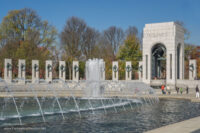 The relatively recent World War II Memorial seems to glorify American power at least as much as it recognizes the sacrifices of those who fought, which seems an odd way to recognize a generation that didn’t expect (or particularly want) adulation for doing what they saw as their duty. The result of a generation of arguments, the memorial is a hodge-podge of competing features. However, there are a few spots that deserve a closer look, including the detailed relief panels highlighting the contributions of both those in the military and at home.
The relatively recent World War II Memorial seems to glorify American power at least as much as it recognizes the sacrifices of those who fought, which seems an odd way to recognize a generation that didn’t expect (or particularly want) adulation for doing what they saw as their duty. The result of a generation of arguments, the memorial is a hodge-podge of competing features. However, there are a few spots that deserve a closer look, including the detailed relief panels highlighting the contributions of both those in the military and at home.
Vietnam Veterans Memorial
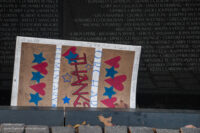 Perhaps appropriately, the Vietnam Veterans Memorial is the opposite of the WW II Memorial – subtle, somber, and clearly focused on those who lost their lives in the war. It’s a heartbreaking space.
Perhaps appropriately, the Vietnam Veterans Memorial is the opposite of the WW II Memorial – subtle, somber, and clearly focused on those who lost their lives in the war. It’s a heartbreaking space.
Of course, it isn’t a war memorial if there aren’t any bronze statues, so the Vietnam Veterans Memorial now also includes the Vietnam Women’s Memorial and the Three Servicemen.
Lincoln Memorial
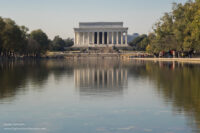 The site of celebration and protest, the Lincoln Memorial is among the most familiar of the monuments on the National Mall. From the steps, visitors have a view all the way down the mall to the Capitol. Inside, the enormous statue of Lincoln is surrounded by his own words from his Second Inaugural Address and the Gettysburg Address.
The site of celebration and protest, the Lincoln Memorial is among the most familiar of the monuments on the National Mall. From the steps, visitors have a view all the way down the mall to the Capitol. Inside, the enormous statue of Lincoln is surrounded by his own words from his Second Inaugural Address and the Gettysburg Address.
Korean War Memorial
 In my mind the Korean War was a mostly pointless slog through bad weather, which is pretty much exactly what the 19 figures that make up the Korean War Memorial convey. There is no glory here, just the reality of the often mundane misery of warfare and the real potential for death. A polished granite wall reflects the memorial’s figures amid etchings of actual soldiers – a wrenching reminder of the real people memorialized here.
In my mind the Korean War was a mostly pointless slog through bad weather, which is pretty much exactly what the 19 figures that make up the Korean War Memorial convey. There is no glory here, just the reality of the often mundane misery of warfare and the real potential for death. A polished granite wall reflects the memorial’s figures amid etchings of actual soldiers – a wrenching reminder of the real people memorialized here.
Jefferson Memorial
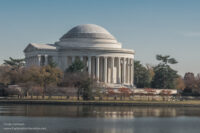 The Jefferson Memorial celebrates the drafter of the Declaration of Independence and third president of the country with a neoclassical temple with a statue of Jefferson and text from a variety of his writings. It’s located in what feels like a secluded spot across the Tidal Basin and a long hike from the rest of the National Mall.
The Jefferson Memorial celebrates the drafter of the Declaration of Independence and third president of the country with a neoclassical temple with a statue of Jefferson and text from a variety of his writings. It’s located in what feels like a secluded spot across the Tidal Basin and a long hike from the rest of the National Mall.
Franklin Delano Roosevelt Memorial
 Visitors to the Franklin Delano Roosevelt Memorial move through a series of open-air rooms depicting the key events of each of FDR’s four terms in office. Stories of the Great Depression, New Deal, WWII, and the beginnings of peace and prosperity are told through bronze sculptures, quotes from FDR’s speeches and letters, and a variety of water features. This design is particularly wonderful at night, when subtle lighting allows the monument to unfold a bit at a time. The memorial is located in a rather isolated area, but a park ranger is usually on duty here until midnight.
Visitors to the Franklin Delano Roosevelt Memorial move through a series of open-air rooms depicting the key events of each of FDR’s four terms in office. Stories of the Great Depression, New Deal, WWII, and the beginnings of peace and prosperity are told through bronze sculptures, quotes from FDR’s speeches and letters, and a variety of water features. This design is particularly wonderful at night, when subtle lighting allows the monument to unfold a bit at a time. The memorial is located in a rather isolated area, but a park ranger is usually on duty here until midnight.
Martin Luther King, Jr. Memorial
 Completed in 2011, the Martin Luther King, Jr. Memorial includes a massive statue of the civil rights leader (carved, oddly, from an almost white granite) standing over the Tidal Basin and a wall with quotes from his speeches. The memorial is located in a pretty spot near the FDR memorial and the original Japanese cherry trees, but separated from the main part of the National Mall by a major roadway.
Completed in 2011, the Martin Luther King, Jr. Memorial includes a massive statue of the civil rights leader (carved, oddly, from an almost white granite) standing over the Tidal Basin and a wall with quotes from his speeches. The memorial is located in a pretty spot near the FDR memorial and the original Japanese cherry trees, but separated from the main part of the National Mall by a major roadway.
DC War Memorial
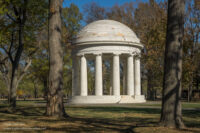 Built in remembrance of DC residents who died in WWI, the DC War Memorial is both a memorial structure and a band shell (it has enough space to accommodate the U.S. Marine Band) that allows the music played here to become a memorial.
Built in remembrance of DC residents who died in WWI, the DC War Memorial is both a memorial structure and a band shell (it has enough space to accommodate the U.S. Marine Band) that allows the music played here to become a memorial.
US Holocaust Memorial Museum
The US Holocaust Memorial Museum opened in 1993 as a “living memorial to the Holocaust, the United States Holocaust Memorial Museum inspires citizens and leaders worldwide to confront hatred, prevent genocide, and promote human dignity.” It is a combination memorial, museum, research center, and leader in the fight against genocide and anti-Semitism around the world. Timed tickets are required to visit the exhibit area during spring and summer.
Planning your visit
The National Mall is one of those places where you can take a quick lunch break by one of the monuments, spend a few hours in a single museum, or spend a full day visiting museums and monuments. There are places (like the Natural History and Air and Space museums) where you will be surrounded by children no matter when you visit and others (like the Sackler Museum) where you may find serene galleries with hardly another soul around. There are a lot of options, so do what fits your interests and time, but try something new too.
We usually start our visit by checking to see what what’s on interest us and then choose which museums to visit accordingly.
Hours and (free) admission
Obviously much of the mall is a park and, as such, is open all day, every day. However, it pays to be aware of what else might be going on in the city before you plan a visit. As the “nation’s front yard,” the Mall regularly hosts major events that include the inauguration of the President and Fourth of July celebration, as well as various races, rallies, protests, and festivals.
With a few exceptions, the Smithsonian museums along the Mall are open every day except Christmas. Most open at 10 and close at 5:30. The Smithsonian Castle (which opens at 8:30) is a notable exception.
All monuments and museums are free, but timed tickets are required to visit the following:
- White House (timed tickets are available only through members of Congress, and generally need to be arranged far in advance)
- United States Capitol (tours are available through members of Congress or the Capitol Visitors Center)
- Washington Monument (currently closed due to elevator issues, but when open, tickets are required to visit the building’s museum and observation deck )
- Holocaust Memorial Museum (timed tickets required during summer)
- Museum of African American History (until the number of visitors subsides, timed tickets are required for all but a few early morning visitors)
Getting to and around the Mall
The National Mall is in the heart of Washington DC, but it is a very big area and can feel quite separated from the surrounding city.
Metro
While four DC Metro rail lines serve the Mall, all Metro stops are all located in the eastern half, leaving the western end of the mall (where most of the monuments and memorials are located) without any rail service.
- The most central Metro stop is Smithsonian, which is located near the Freer Gallery and the Smithsonian Castle, to the east of the Washington Memorial.
- The Federal Triangle stop is directly north of Smithsonian. It’s just north of the American History Museum and the Natural History Museum.
- Archives/Navy Memorial is located closer to the east end of the Mall, just north of the National Gallery of Art and its Sculpture Garden
DC Circulator
Relying on Metro will result in a LOT of walking if you want to tour the entire Mall (or even just the west end), but the DC Circulator (one of my best DC discoveries) recently expanded to provide service to the National Mall.

In 2016 buses ran every 10 minutes from 7 a.m. to 8 p.m. (7 p.m. in winter) on weekdays and 9 a.m. to 9 p.m. (7 p.m. in winter) on weekends.
The Circulator charges $1 per trip if the fare is paid in cash. Riders with a fare card can exit and reboard within 2 hours of the time they first boarded for a $1. Seniors over age 65 can ride for half that.
This is a transportation service, NOT a tour. There is no narration as you travel. However, the route has lots of conveniently located stops and I highly recommend it for visiting the Mall.
Capital Bikeshare
 For those who don’t mind a bit of exercise and who would like to tour the (pretty much flat) Mall a little faster, Capital Bikeshare has stations scattered along and throughout the Mall. An interactive map shows users where bikes stations are located and availability.
For those who don’t mind a bit of exercise and who would like to tour the (pretty much flat) Mall a little faster, Capital Bikeshare has stations scattered along and throughout the Mall. An interactive map shows users where bikes stations are located and availability.
There are a variety of rental options, including rentals for a single trip, one day, three day, and more. For those willing to put out a very minimal initial membership fee, individual trips might actually be free, as members are only charged for trips over 30 minutes. On a day when not too many people are using the service (making it is easy to exchange bikes at most stops), it should be possible to spend the entire day exploring the National Mall at little or no charge beyond the initial membership fee.
Restrooms
There are public restrooms in all of the museums and in pavilions throughout the Mall.
Eating and drinking
Bring water with you. The Mall is two miles long and has a limited amount of shade. Yes, you can buy water along the Mall, but the prices won’t make you very happy.
Most museums along the Mall turn their back to the surrounding city, putting the restaurants and food trucks found along many busy city streets out of sight. That doesn’t mean they aren’t there. The variety and quality of restaurants off the Mall can make searching them out a worthwhile task.
DC has a growing food truck scene and several interactive maps make it easy to find out what food trucks may be hanging out just off the Mall. Checking Food Truck Fiesta and Roaming Hunger may lead you to the chef who will open DC’s next great restaurant!
A number of the Smithsonian museums have cafes. Most are geared toward families and all of them are expensive for what you get. Menus tend to be pretty basic and the quality varies wildly. I’ve generally found (not surprisingly) that the more popular the museum is with children, the more the café caters to their taste. That doesn’t mean the food is worse at those museums, but the options will be more limited.
The best of the bunch is probably the Mitsitam Native Foods Café in the American Indian Museum, which has seasonally changing menu items from various parts of the Americas. The wide variety, complete meals, and more unusual options make it stand out from the others. In the past the quality has also been very high, but on my last visit it felt as if both quality and value had decreased while prices had increased.
As much as I hate to even mention it, there is a McDonald’s on the Mall at the Air and Space Museum. It isn’t any worse than most of the museum cafes and you’ll know what to expect.
Small food stands selling hot dogs, ice cream, snacks, and water can also be found along the Mall.